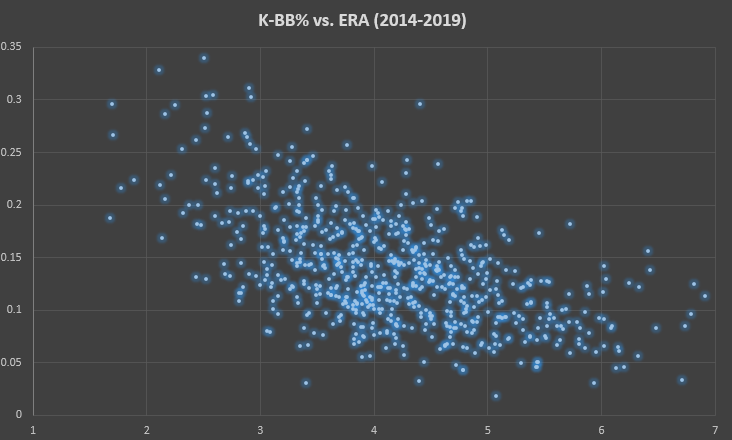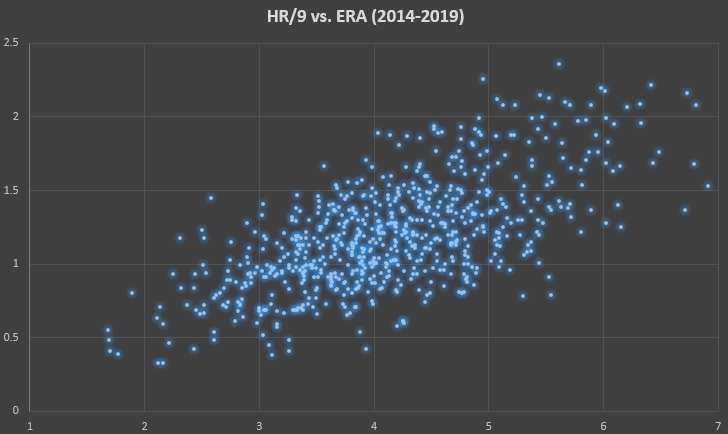Starting pitching is a finicky thing in the fantasy world. There is certain to be lots of impactful injuries, breakouts, and busts this year within the starting pitching position.
After the first handful of rounds of the draft, it gets pretty tough to find guys you can feel confident about helping your team in the ERA category. But if you can find a few guys late in the draft that post great ERA's this year, you're well on your way to success.
Here we will explore the ERA category a bit and then nominate a few pitchers that may prove to be great targets in the middle or later rounds to help your team in that category. You can also read other articles in this series for my breakdowns of other later-round category targets.
Featured Promo: Want a free RotoBaller Premium Pass? Check out these sports betting promo offers from the top sportsbooks! All new sign-ups get a free bonus offer on their first deposit, and a free year of RotoBaller's Premium Pass for all sports ($450 value)! Sign Up Now!
Where Does ERA Come From?
I went through pitchers that have thrown 100+ innings pitched in a season from 2014-2019 and examined correlations with different statistical categories and ERA. The goal here is to find certain "skills" that most correlate to ERA, and then use that information to identify which later-round pitchers have these skills. There were really two categories that stuck out. Here they are.
K-BB%
Earned runs come from baserunners. Baserunners come from hits and walks. Hits come from putting the ball in play. Ipso facto, pitchers that avoid walking hitters and allowing balls to be put in play will post better ERAs. This is incredibly intuitive and probably doesn't even need proven, but here's a plot anyways.

What you see here is the relationship between K-BB% and ERA. You can see that as your K-BB% gets lower, your ERA gets higher.
K-BB% is just what it says, a pitcher's strikeout rate minus their walk rate. The gold standard is Gerrit Cole's 2019 season where he posted a 39.9% strikeout rate with a 5.9% walk rate. Doing the subtraction gives you a 34% K-BB%. He is represented by the highest dot on the plot above, and you can see that his ERA on the x-axis shows up at 2.50.
On the other side of things, the worst we have seen is actually Tyler Chatwood's 2019 season when he posted a 17.5% strikeout rate with a 19.5% walk rate, resulting in a negative K-BB% of -2.1%. I actually left that dot off the plot cause negative values on the y-axis make it look really dumb, but you can see how this works now.
When we look at the leaders in this category over the last two years, it's just a bunch of studs that you have to pay a high draft cost for. Here are the top ten using 2019 and 2020 data together.
| Pitcher | K% | BB% | K-BB% |
| Gerrit Cole | 38% | 6% | 32% |
| Justin Verlander | 35% | 5% | 30% |
| Chris Sale | 36% | 6% | 30% |
| Max Scherzer | 34% | 6% | 28% |
| Jacob deGrom | 34% | 6% | 28% |
| Shane Bieber | 33% | 5% | 28% |
| Dinelson Lamet | 34% | 9% | 25% |
| Yu Darvish | 31% | 7% | 24% |
| Lucas Giolito | 33% | 9% | 24% |
| Mike Clevinger | 32% | 8% | 24% |
Not very helpful for our purposes.
Looking at pitchers that show up high on this leaderboard with more affordable ADP's, here are some names:
| Pitcher | ADP | K-BB% |
| Stephen Strasburg | 71 | 22.7% |
| Charlie Morton | 119 | 22.4% |
| Carlos Carrasco | 66 | 21.7% |
| Kevin Gausman | 132 | 20.8% |
| Chris Paddack | 109 | 20.7% |
| Andrew Heaney | 203 | 20.2% |
| Zack Greinke | 108 | 19.9% |
| Domingo German | 301 | 19.9% |
| Jake Odorizzi | 282 | 18.7% |
| Frankie Montas | 151 | 18.5% |
| Michael Pineda | 227 | 18.3% |
| Joe Musgrove | 130 | 17.8% |
| Tyler Mahle | 170 | 17.7% |
| Ryan Yarbrough | 246 | 16.2% |
| Griffin Canning | 289 | 15.9% |
| Mike Minor | 288 | 15.8% |
HR/9
Keeping the ball in the yard is also quite helpful to your ERA, which is again - very obvious. Here's the relationship

What's the best way to limit homers? Probably the best way is to limit contact, which we've already discussed. But there are several pitchers who do a great job preventing homers while not striking out a ton of guys. Those pitchers typically do it by getting a ton of ground-balls. I sorted my data by ground-ball rate, limiting the results to pitchers that are being drafted in the top 400. Here's what that looks like:
| Pitcher | ADP | GB% |
| Framber Valdez | 91 | 61% |
| Lance McCullers Jr. | 117 | 60% |
| Sixto Sanchez | 133 | 58% |
| Dallas Keuchel | 195 | 58% |
| Luis Castillo | 25 | 57% |
| Carlos Martinez | 394 | 56% |
| Max Fried | 64 | 54% |
| Ian Anderson | 96 | 54% |
| Marcus Stroman | 213 | 54% |
| Brady Singer | 232 | 54% |
| Mike Soroka | 171 | 54% |
| Hyun-Jin Ryu | 74 | 52% |
| Sonny Gray | 65 | 52% |
| Justus Sheffield | 275 | 52% |
| Dustin May | 168 | 51% |
| Stephen Strasburg | 71 | 51% |
| Brad Keller | 300 | 51% |
| Jameson Taillon | 222 | 51% |
| Aaron Nola | 22 | 51% |
| German Marquez | 166 | 50% |
| Pablo Lopez | 121 | 50% |
These are some of the best ground-ball pitchers in the game, which does help their ERA projections. However, you still want some strikeouts to be present to feel good about getting a helpful ERA. In the cases of Keuchel, Stroman, Singer, Sheffield, May, and Keller - you are not going to get strikeouts. Those are strict pitch-to-contact guys who are susceptible to bloated ERA's influenced heavily by bad luck. Letting a ball be put in play opens you up to the hitter reaching base.
The names on this list that can achieve high strikeout rates: Valdez, McCullers, Sanchez, Castillo, Martinez, Anderson, Gray, Strasburg, Nola, Lopez. I think if those names can stay healthy, they have a really good shot at crushing their draft prices.
Weak Fly Balls
A weakly hit fly ball is even better than a ground-ball, as those batted ball types go for an out at a very high rate. Here's the slugging percentages hitters achieve on average at each exit velocity:

The goal, then, is to keep the fly-balls you do give up under 95 miles per hour, as that is really where the slugging percentage starts to bottom out.
We can then look into which pitchers have been able to limit the exit velocity on the fly balls they have given up, and this could potentially point out some pitchers that could exceed expectations in ERA. The problem with this is, it's not as predictive a stat as ground-ball rate is. Ground-ball rate is very steady year-to-year, while exit velocity measures have not proven to be.
Here's the average exit velocity on fly balls leaderboard from the last two seasons:
| Pitcher | ADP | FB Velo |
| Spencer Howard | 362 | 85.1 |
| Lance McCullers Jr. | 117 | 85.2 |
| Sixto Sanchez | 113 | 86.1 |
| Kwang Hyun Kim | 262 | 86.5 |
| Michael Lorenzen | 380 | 87.9 |
| Aaron Civale | 183 | 88.2 |
| Mitch Keller | 293 | 88.4 |
| Hyun-Jin Ryu | 74 | 88.6 |
| Julio Urias | 114 | 88.6 |
| Ian Anderson | 96 | 88.9 |
| Deivi Garcia | 306 | 88.9 |
| Zack Wheeler | 90 | 89.1 |
| Charlie Morton | 119 | 89.2 |
| Ryan Yarbrough | 246 | 89.3 |
| Kyle Hendricks | 85 | 89.5 |
Conclusion
So there are three categories to look for when you're trying to find a late-round pitcher to help you in ERA. To sum it all up and give you some actionable advice, here are my top 13 pitchers for ERA help in the middle or late in the draft this year.
| Pitcher | ADP |
| Stephen Strasburg | 71 |
| Julio Urias | 114 |
| Lance McCullers Jr. | 117 |
| Charlie Morton | 119 |
| Pablo Lopez | 121 |
| Sixto Sanchez | 133 |
| Aaron Civale | 183 |
| Dallas Keuchel | 195 |
| Andrew Heaney | 203 |
| Michael Pineda | 227 |
| Ryan Yarbrough | 246 |
| Mike Minor | 288 |
| Griffin Canning | 289 |
Download Our Free News & Alerts Mobile App
Like what you see? Download our updated fantasy baseball app for iPhone and Android with 24x7 player news, injury alerts, sleepers, prospects & more. All free!

More 2021 Fantasy Baseball Advice
 RADIO
RADIO





















